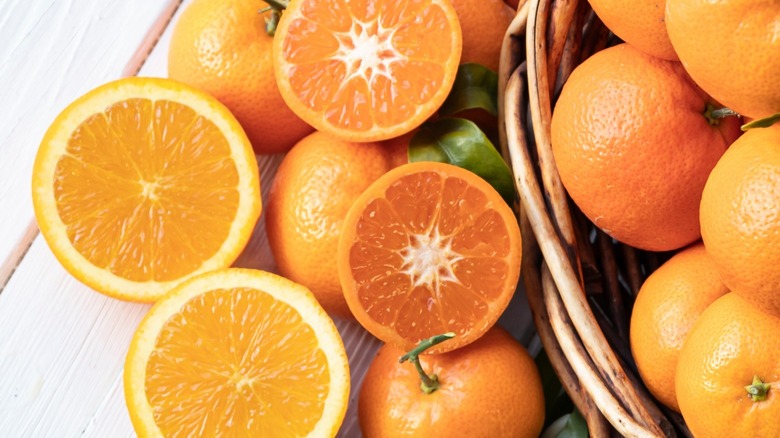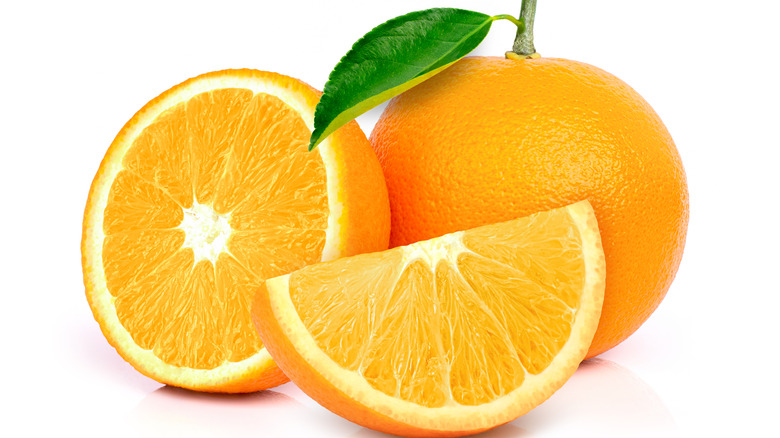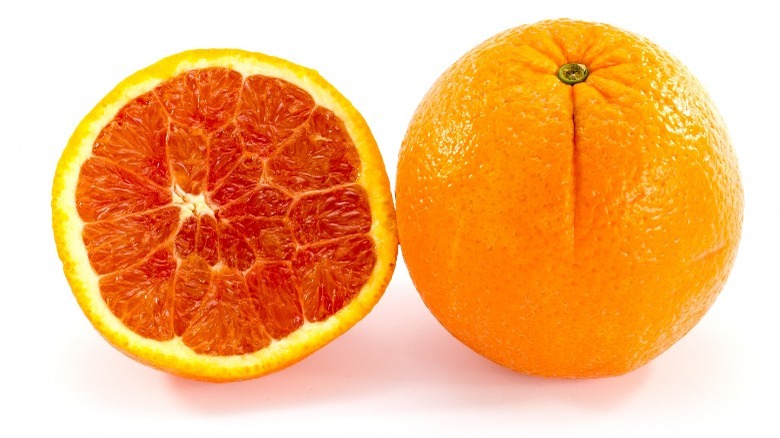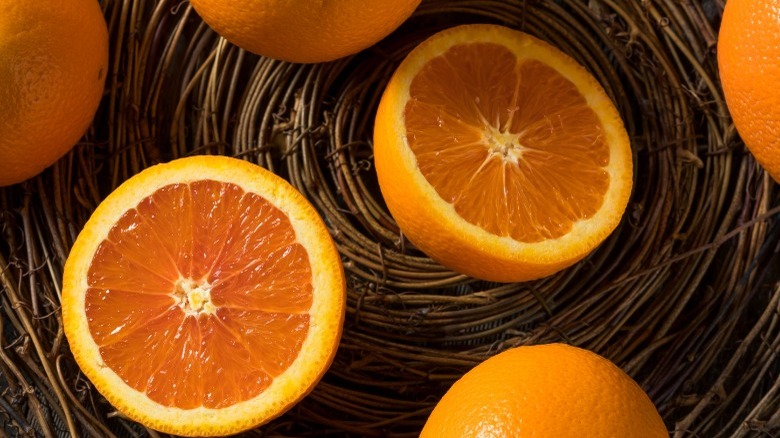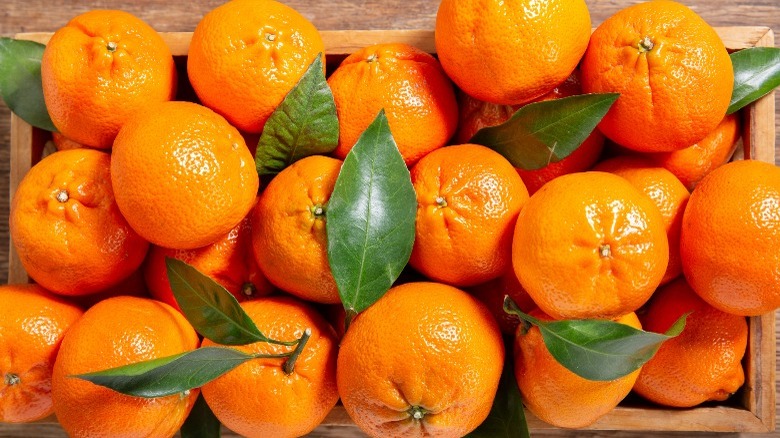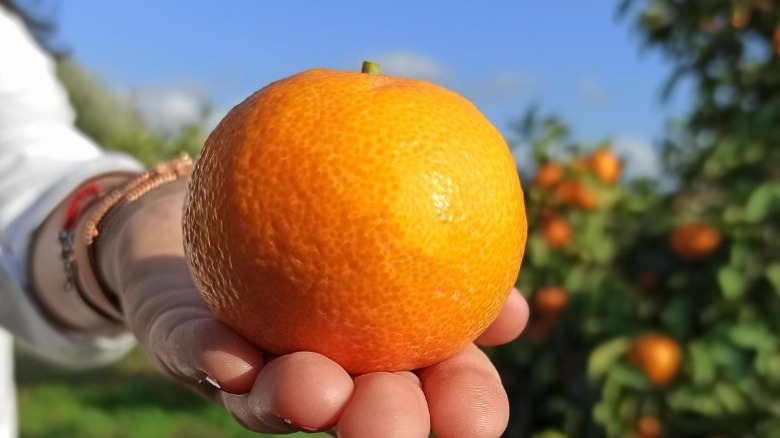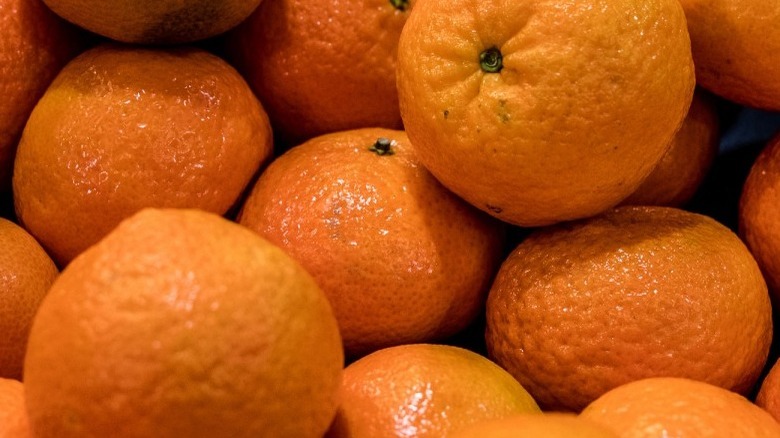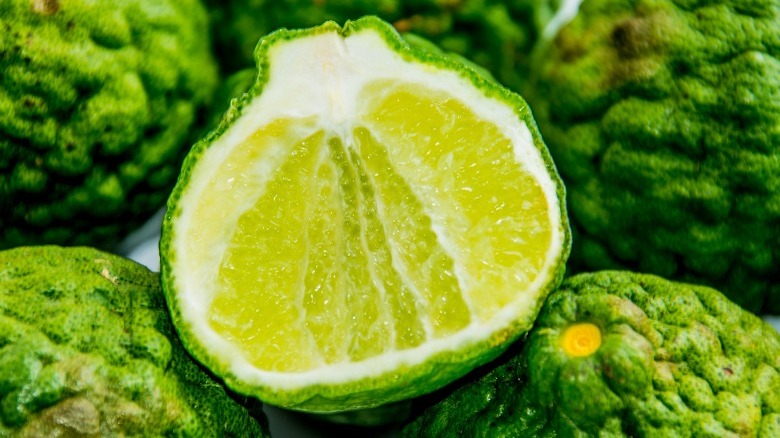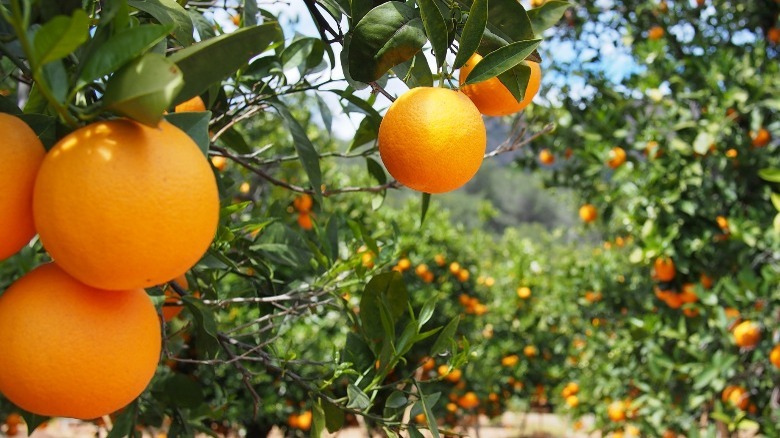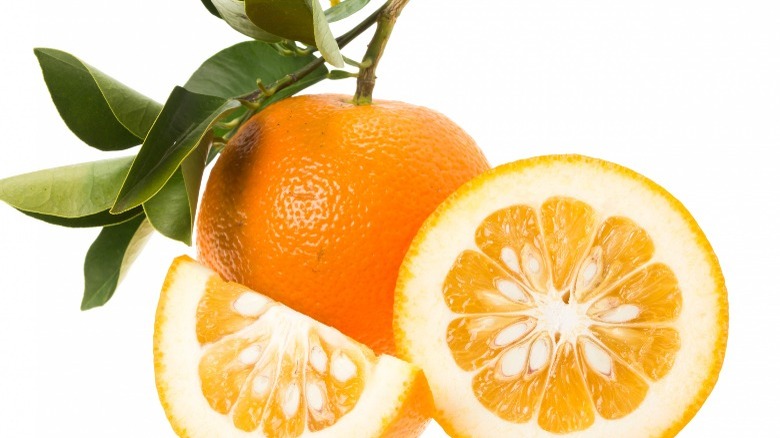The Most Popular Types Of Oranges Ranked
There is nothing more refreshing than a juicy orange. Whether it's that first sip of freshly squeezed orange juice served with your scrambled eggs and bacon at breakfast or that peeled slice you're enjoying as a midday, post-workout snack, oranges quench your thirst no matter the occasion. Oranges are also incredibly versatile: Not only can they be eaten as a snack or enjoyed as a juice, but they can be used in a variety of different recipes to add some extra tanginess to your dishes. Plus, they are packed with all the good things for you, like vitamin C, antioxidants, and fiber, which Medical News Daily says can help keep your heart healthy.
But not all oranges are the same. There are many varieties of oranges that come in different sizes and shapes, each with their own unique tastes and uses. Some are better for juicing than others, while a few shouldn't be eaten at all, instead only used for their fragrant aroma. While you may think you know most of the oranges on the market, you might be surprised there are still a few a little less known. We broke down the most popular types of oranges and ranked the nine best to help make your trip to the produce aisle all the easier.
1. Navel orange
If you're at the grocery store and reach for a big ol' orange, chances are you're grabbing a navel. This big boy is one of the most popular types of oranges around and gets its name from its navel-like shape (check out the opposite end of the stem and you'll see what looks like a belly button), something that is created by a genetic mutation, which Citrus.com says goes all the way back to the 1800s.
Navel oranges can be pretty hit or miss when it comes to juiciness, so they might not always be ideal for juicing. Another thing to note is its juice can become bitter quickly, so if you find a juicy navel and are using it for juice, it's best to drink it right away (via Los Angeles Times). Due to its size and being seedless, a navel orange is great for snacking with its sweet but slightly tangy taste that won't disappoint. Plus with such a thick skin, it makes for easy peeling (and won't get offended when you poke fun of its innie).
2. Blood orange
While the name might not sound all that appealing (or something straight out of an horror flick), blood oranges are pretty popular — and for good reason. With a combination of the pomelo (the biggest citrus fruit around) and the tangerine (more on this guy later), you'll be able to spot a blood orange easily once you slice it open (via P Magazine). Its gorgeous ruby flesh and equally red juice come from anthocyanins, which Heal With Food says are flavonoid pigments found in certain fruits and vegetables. Blood oranges are tart and sweet, and also very juicy — so keep a napkin handy when you eat one. While great on its own (and oh so refreshing) blood orange is also a perfect addition to any savory or sweet recipe and a stand-out garnish. Blood Orange Hot Toddy, anyone?
This orange is no doubt a stunner and incredibly tasty, but it also helps keep you healthy. WebMD explains it's rich in vitamin C (like most citrus), but it also boosts the ability to help reduce the risk of a stroke thanks to being high in those flavonoids mentioned above, which provide anti-inflammatory benefits. This ruby red orange is more than just a pretty flesh after all.
3. Cara cara orange
The cara cara orange is large like a navel orange and has a pinker flesh similar to a blood orange, making it the best of both worlds. It's a decent-sized orange that's relatively juicy, making it one worth enjoying on its own. The cara cara orange gets that pretty pink flesh from the antioxidant called lycopene, shares Sunkist, which not only looks good but has some serious health benefits too. This antioxidant can help reduce your stress levels while protecting you from some toxins found in our everyday environment (via Healthline).
When you peel this orange and bite into its pink flesh, you'll notice it's much sweeter than some of the other varieties on this list, making it one of the most popular types of oranges. You'll also notice that a cara cara has a lower acidity level, according to The Fruit Guys. No sharp or sour bite here. Instead, you may pick up hints of berries or cherries when you're eating this citrus, making it one big fruity concoction in your mouth.
4. Mandarin
Don't let the size of a mandarin fool you — it may be small, but its taste (and health benefits) are mighty. These little ones are believed to have originally come from China, which is how they got their name according to the Produce Blue Book. Mandarins have an semi-oblong shape rather than being round like some of the other, larger varieties of oranges. The Produce for Better Health Foundation says mandarin oranges have more copper than some other fruits (which can help prevent tissue damage and is good for both your immune system and heart, reports VeryWell Health) and has a flavor that won't let you down. Mandarins are sweet and pretty easy to peel thanks to their loose skin.
While mandarin oranges may be too tiny to be worth juicing, these little guys are the perfect on-the-go snack with the small shape that fits in your hand. Mandarins can also be used in fresh winter salads (they sit pretty on top of any greenery) and many different kinds of desserts (think: cakes and curds) for the ultimate citrus treat.
5. Tangerine
In the same family as a mandarin, a tangerine is a bright shade of orange on the outside with a darker orange flesh on the inside. It is on the smaller side (but not as small as a mandarin) and very easy to peel due to its soft skin. As for the taste, expect a bit more tart to the bite with some tanginess, according to the experts at S & J Mandarin Grove. But don't worry, it is still sweet enough to enjoy as a snack ... just watch out for seeds.
As most of the oranges on this list, tangerines are packed with lots of the good stuff that can help keep you looking and feeling your best. WebMD reports tangerines have a ton of vitamin C which can help boost collagen in the skin for that healthy, "youthful" glow. While also boosting antioxidants, Healthline states tangerines are full of both potassium and B complex vitamins, can help regulate blood pressure, and help with brain function and digestion.
6. Clementines
As another citrus that is also part of the mandarin family, there's a reason why clementines sometimes go by the product name Cuties or Halos. These miniature, oval-shaped babies are adorable and seem sent from the heavens as one of the sweetest citrus fruits around. The skin is smoother than most other citrus and shinier, which helps make it all the easier to peel. And since clementines are so easy to peel, small, and sweet, they are a super popular type of oranges with the kiddos, making them a win for parents.
But kids aren't the only ones reaping the benefits when eating clementines; these small oranges help promote a healthy diet for kids and adults alike. They are low in carbohydrates, according to EatingWell, and (of course) packed with vitamin C and antioxidants like other citrus to keep you healthy. Something else adults might like: Spiced Clementine Sours – your winter cocktail hour just got a whole lot better.
7. Bergamot Orange
Bergamot oranges don't look like your average orange. In fact, they really don't even look like an orange at all! This medium-sized citrus sports a yellow or green exterior, looking more like an oddly shaped, oversized lemon or lime. Another big difference between bergamots and other varieties of oranges? The Farmers' Almanac states they are not usually eaten fresh. That's right — this type of orange is super sour and not one you'll likely crave when wanting a glass of OJ or morning snack.
But it's not the flesh or the juice that makes this orange sought after, it's the fragrant peel. If you're an Earl Grey drinker, you probably know what we mean. The Farmers' Almanac explains the peel is one of the key ingredients that gives this tea its unique sip. Bergamot peels are also used in many perfumes and candles, providing a lovely hint of floral and citrus. While bergamot provides a nice aroma, it also offers some health benefits too: the essential oils from the rinds can help kick stress and anxiety, says VeryWell Mind.
8. Valencia
If you're in the mood for the best freshly squeezed orange juice, a valencia orange is just what you need. Named after Valencia, Spain, this orange is usually round and large in size with bright orange skin and incredibly juicy flesh (which is why it's a must for juicing). Hale Groves shares that, unlike navel oranges, the flesh of a valencia does not have that pesky limonin compound that makes juice become bitter in a short period of time, so you don't have to worry about it losing its sweetness. But juicing this orange isn't the only way to enjoy it. Eat valencia oranges on their own or in any recipe of your choosing that could benefit from a bit of sunshine, raw or cooked.
While most of the other oranges are harvested in the winter, valencia oranges are harvested in the summer months, according to Gardening Know How, so be sure to plan around their schedule when you grow a hankering for their juicy sweetness.
9. Seville
Weighing in as our least common orange, a seville orange may look pretty average in size and color, but it's anything like the others. As Citrus Variety Collection calls it the "sour orange," sevilles aren't necessarily one of the most popular types of oranges since they are very tart, acidic, and well, downright bitter (via Specialty Produce). Not necessarily the tasting notes you think of when it comes to a juicy orange.
But not all is lost on the seville orange by any means! Instead of eating it raw, Specialty Produce suggests this orange is the perfect choice for creating orange marmalade. If homemade jam isn't really your thing, seville oranges can be used in many other dishes, too. Just be sure to stick to using the citrus in a cooked application, rather than anything raw (remember its apt nickname). When cooking with this citrus, don't forget about using the peel too as it makes for delicious candied-orange sweets or a zesty garnish.
